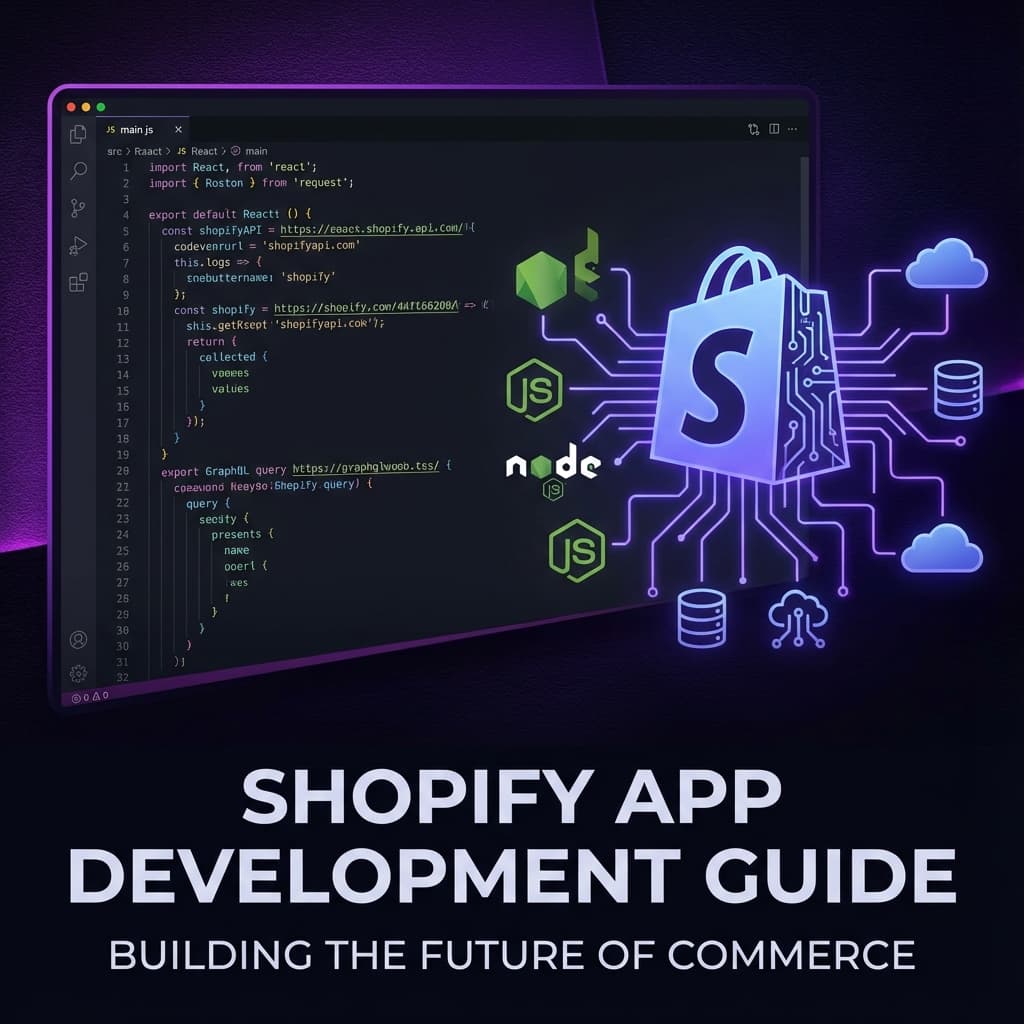
Shopify App entwickeln: Eine ehrliche Anleitung 2025
Sie haben eine Idee für eine Shopify App? Vielleicht eine interne Lösung für Ihren eigenen Shop oder ein Produkt für den App Store? In diesem umfassenden Guide zeige ich Ihnen den kompletten Weg – von der ersten Idee bis zur produktionsreifen App.
Die drei Arten von Shopify Apps
Bevor wir in die Entwicklung einsteigen, müssen Sie verstehen, welche App-Typen es gibt:
1. Custom Apps (ehemals Private Apps)
Für wen? Einzelne Shops, die eine maßgeschneiderte Lösung brauchen.
- ✅ Direkter API-Zugriff ohne Authentifizierungs-Flow
- ✅ Keine App-Store-Review nötig
- ✅ Volle Kontrolle über Funktionalität
- ❌ Nur für einen Shop nutzbar
- ❌ Keine Einnahmen durch andere Händler
Typische Anwendungsfälle:
- ERP-Integration (SAP, Microsoft Dynamics)
- Custom Dashboard mit Geschäftslogik
- Automatisierte Workflows (Lagerbestand, Rechnungen)
2. Public Apps (App Store)
Für wen? Entwickler, die eine Lösung für viele Händler anbieten wollen.
- ✅ Skalierbare Einnahmen (Abo-Modelle)
- ✅ Millionen potenzieller Kunden
- ✅ Shopify-Marketing-Support
- ❌ Strenge Review-Prozesse
- ❌ 20% Revenue Share an Shopify
- ❌ Komplexere Architektur (OAuth, Webhooks)
3. Unlisted Apps
Für wen? Agenturen, die Apps für mehrere Kunden entwickeln.
- ✅ Wiederverwendbare Lösung
- ✅ Kein App-Store-Review
- ✅ Flexibles Pricing
- ❌ Manueller Installationslink nötig
- ❌ Kein Marketplace-Exposure
Der Tech-Stack 2025
Das offizielle Shopify Stack
Shopify empfiehlt und unterstützt folgende Technologien:
Frontend: React + Polaris (Shopify's Design System)
Backend: Node.js + Express oder Remix
Database: PostgreSQL oder MongoDB
Hosting: Vercel, Railway, Fly.io
Auth: @shopify/shopify-api (OAuth 2.0)
Shopify CLI: Ihr bester Freund
Die Shopify CLI ist das zentrale Werkzeug für die App-Entwicklung:
# Neue App erstellen
npm init @shopify/app@latest
# Entwicklungsserver starten
npm run dev
# App deployen
npm run deploy
Die CLI generiert automatisch:
- OAuth-Flow
- Session Management
- Polaris-Integration
- Webhook-Handler
- App Bridge für eingebettete Apps
Die Shopify APIs verstehen
Admin API (GraphQL)
Die wichtigste API für Backend-Operationen:
# Produkte abrufen
query {
products(first: 10) {
edges {
node {
id
title
variants(first: 5) {
edges {
node {
price
inventoryQuantity
}
}
}
}
}
}
}
Rate Limits:
- Standard: 1000 Punkte/Sekunde
- Plus: 2000 Punkte/Sekunde
Storefront API
Für Kundenseitige Anwendungen (Headless, PWA):
- Öffentlich zugänglich (mit Storefront Access Token)
- Lese-Zugriff auf Produkte, Collections
- Cart-Management
- Customer Account API
Webhook-Subscriptions
Webhooks sind essentiell für reaktive Apps:
// Webhook für neue Bestellungen
app.post('/webhooks/orders/create', async (req, res) => {
const order = req.body;
// Ihre Geschäftslogik
await processNewOrder(order);
res.status(200).send('OK');
});
Wichtige Webhooks:
orders/create– Neue Bestellungproducts/update– Produktänderungapp/uninstalled– App deinstalliertcustomers/data_request– DSGVO-Anfrage
App-Architektur Best Practices
1. Embedded vs. Standalone
Embedded Apps (empfohlen):
- Läuft innerhalb des Shopify Admin
- Nutzt App Bridge für nahtlose UX
- Single Sign-On automatisch
Standalone Apps:
- Eigene Domain
- Volles Design-Control
- Komplexerer Auth-Flow
2. Session Storage
Shopify-Sessions müssen persistent gespeichert werden:
import { shopifyApp } from '@shopify/shopify-app-express';
import { PrismaSessionStorage } from '@shopify/shopify-app-session-storage-prisma';
const shopify = shopifyApp({
sessionStorage: new PrismaSessionStorage(prisma),
// ...
});
3. Background Jobs
Für lange Operationen nutzen Sie Queues:
// Bull.js für Background Jobs
const queue = new Bull('sync-products');
queue.process(async (job) => {
const { shopDomain } = job.data;
await syncAllProducts(shopDomain);
});
Kosten und Zeitaufwand
Entwicklungskosten (realistisch)
| App-Typ | Zeitaufwand | Kosten (Agentur) | |---------|-------------|------------------| | Simple Custom App | 40-80h | €4.000 - €8.000 | | Komplexe Custom App | 120-200h | €12.000 - €25.000 | | Public App (MVP) | 200-400h | €25.000 - €50.000 | | Public App (Full) | 400-800h | €50.000 - €100.000 |
Laufende Kosten
- Hosting: €20-100/Monat (Vercel, Railway)
- Database: €20-50/Monat (PlanetScale, Supabase)
- Monitoring: €0-50/Monat (Sentry)
- Shopify Partner Gebühren: Kostenlos (20% Revenue Share bei App Store)
Der App Store Review Prozess
Wenn Sie eine Public App entwickeln, müssen Sie durch das Review:
1. Technische Anforderungen
- ✅ HTTPS überall
- ✅ Korrekter OAuth-Flow
- ✅ GDPR-Webhooks implementiert
- ✅ Keine deprecated APIs
- ✅ Performance unter 3s Ladezeit
2. UX/Design Anforderungen
- ✅ Polaris-konformes Design
- ✅ Responsive Layout
- ✅ Accessibility (WCAG 2.1)
- ✅ Klare Onboarding-Experience
3. Business Anforderungen
- ✅ Transparentes Pricing
- ✅ Funktionierender Support-Kanal
- ✅ Privacy Policy
- ✅ Terms of Service
Timeline: 2-6 Wochen für das erste Review
Monetarisierung
Pricing-Modelle
-
Subscription (beliebt)
- "Starter: $9/Monat"
- "Pro: $29/Monat"
- "Enterprise: Custom"
-
Usage-Based
- "Pro Bestellung: $0.10"
- "Pro API-Call: $0.001"
-
Freemium
- Kostenlose Basis-Features
- Premium-Upgrade
Shopify Billing API
Nutzen Sie die eingebaute Billing API für nahtlose Abrechnung:
const response = await client.request(
`mutation {
appSubscriptionCreate(
name: "Pro Plan"
lineItems: [{
plan: {
appRecurringPricingDetails: {
price: { amount: 29.00, currencyCode: USD }
}
}
}]
returnUrl: "${process.env.HOST}/billing/confirm"
) {
confirmationUrl
}
}`
);
Häufige Fehler vermeiden
1. Rate Limits ignorieren
Implementieren Sie immer Retry-Logic mit exponential Backoff.
2. Webhooks nicht verifizieren
Sicherheitsrisiko! Verifizieren Sie jeden Webhook mit HMAC:
const verified = shopify.webhooks.validate({
rawBody: req.rawBody,
hmac: req.headers['x-shopify-hmac-sha256'],
});
3. Keine Offline-Tokens
Speichern Sie Offline Access Tokens für Background-Jobs.
4. Schlechtes Error Handling
Shopify-APIs geben detaillierte Fehlermeldungen – nutzen Sie diese!
Fazit
Shopify App-Entwicklung ist komplex, aber lohnend. Starten Sie mit einer Custom App für einen einzelnen Shop, um die APIs zu lernen. Erst wenn Sie die Grundlagen beherrschen, wagen Sie sich an Public Apps.
Mein Tipp: Nutzen Sie die offiziellen Shopify-Tutorials und die Partner-Community. Dort finden Sie Antworten auf fast jede Frage.
Brauchen Sie Unterstützung bei Ihrer Shopify App? Kontaktieren Sie mich für ein unverbindliches Gespräch. Ich helfe Ihnen von der Konzeption bis zum Launch.

Über den Autor
Justin Kreutzmann ist Experte für Shopify-Entwicklung und E-Commerce-Skalierung. Er hilft Marken dabei, technische Grenzen zu überwinden und performante Online-Shops zu bauen.
Zusammenarbeiten →